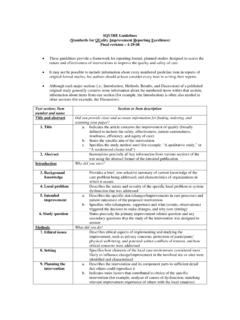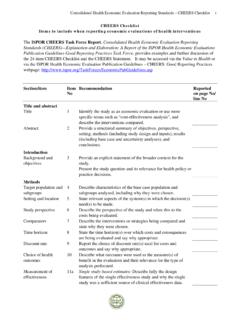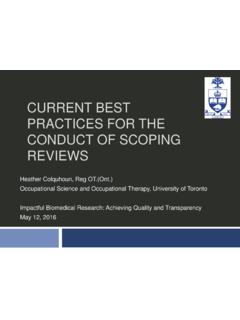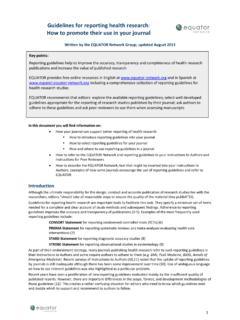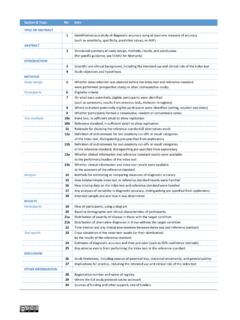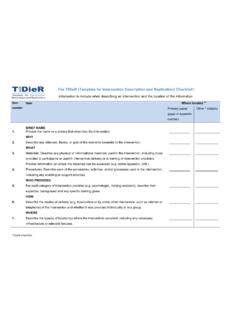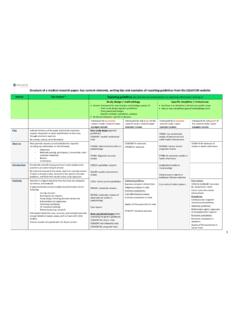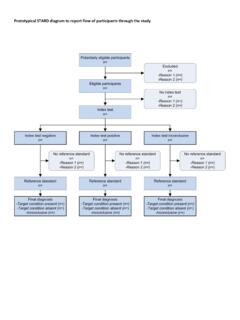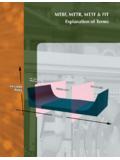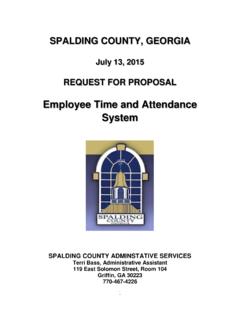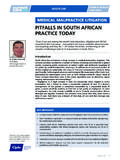Transcription of Revised Standards for Quality Improvement …
1 Revised Standards for Quality Improvement reporting excellence (SQUIRE ) September 15, 2015 Text Section and Item Name Section or Item Description Notes to authors The SQUIRE guidelines provide a framework for reporting new knowledge about how to improve healthcare The SQUIRE guidelines are intended for reports that describe system level work to improve the Quality , safety, and value of healthcare, and used methods to establish that observed outcomes were due to the intervention(s). A range of approaches exists for improving healthcare.
2 SQUIRE may be adapted for reporting any of these. Authors should consider every SQUIRE item, but it may be inappropriate or unnecessary to include every SQUIRE element in a particular manuscript. The SQUIRE Glossary contains definitions of many of the key words in SQUIRE. The Explanation and Elaboration document provides specific examples of well-written SQUIRE items, and an in-depth explanation of each item. Please cite SQUIRE when it is used to write a manuscript. Title and Abstract 1. Title Indicate that the manuscript concerns an initiative to improve healthcare (broadly defined to include the Quality , safety, effectiveness, patient-centeredness, timeliness, cost, efficiency, and equity of healthcare) 2.
3 Abstract a. Provide adequate information to aid in searching and indexing b. Summarize all key information from various sections of the text using the abstract format of the intended publication or a structured summary such as: background, local problem, methods, interventions, results, conclusions Introduction Why did you start? 3. Problem Description Nature and significance of the local problem 4. Available knowledge Summary of what is currently known about the problem, including relevant previous studies 5. Rationale Informal or formal frameworks, models, concepts, and/or theories used to explain the problem, any reasons or assumptions that were used to develop the intervention(s), and reasons why the intervention(s) was expected to work 6.
4 Specific aims Purpose of the project and of this report Methods What did you do? 7. Context Contextual elements considered important at the outset of introducing the intervention(s) 8. Intervention(s) a. Description of the intervention(s) in sufficient detail that others could reproduce it b. Specifics of the team involved in the work 9. Study of the Intervention(s) a. Approach chosen for assessing the impact of the intervention(s) b. Approach used to establish whether the observed outcomes were due to the intervention(s) 10. Measures a. Measures chosen for studying processes and outcomes of the intervention(s), including rationale for choosing them, their operational definitions, and their validity and reliability b.
5 Description of the approach to the ongoing assessment of contextual elements that contributed to the success, failure, efficiency, and cost c. Methods employed for assessing completeness and accuracy of data 11. Analysis a. Qualitative and quantitative methods used to draw inferences from the data b. Methods for understanding variation within the data, including the effects of time as a variable 12. Ethical Considerations Ethical aspects of implementing and studying the intervention(s) and how they were addressed, including, but not limited to, formal ethics review and potential conflict(s) of interest Results What did you find?
6 13. Results a. Initial steps of the intervention(s) and their evolution over time ( , time-line diagram, flow chart, or table), including modifications made to the intervention during the project b. Details of the process measures and outcome c. Contextual elements that interacted with the intervention(s) d. Observed associations between outcomes, interventions, and relevant contextual elements e. Unintended consequences such as unexpected benefits, problems, failures, or costs associated with the intervention(s). f. Details about missing data Discussion What does it mean?
7 14. Summary a. Key findings, including relevance to the rationale and specific aims b. Particular strengths of the project 15. Interpretation a. Nature of the association between the intervention(s) and the outcomes b. Comparison of results with findings from other publications c. Impact of the project on people and systems d. Reasons for any differences between observed and anticipated outcomes, including the influence of context e. Costs and strategic trade-offs, including opportunity costs 16. Limitations a. Limits to the generalizability of the work b.
8 Factors that might have limited internal validity such as confounding, bias, or imprecision in the design, methods, measurement, or analysis c. Efforts made to minimize and adjust for limitations 17. Conclusions a. Usefulness of the work b. Sustainability c. Potential for spread to other contexts d. Implications for practice and for further study in the field e. Suggested next steps Other information 18. Funding Sources of funding that supported this work. Role, if any, of the funding organization in the design, implementation, interpretation, and reporting Table 2.
9 Glossary of key terms used in SQUIRE This Glossary provides the intended meaning of selected words and phrases as they are used in the SQUIRE Guidelines. They may, and often do, have different meanings in other disciplines, situations, and settings. Assumptions Reasons for choosing the activities and tools used to bring about changes in healthcare services at the system level. Context Physical and sociocultural makeup of the local environment (for example, external environmental factors, organizational dynamics, collaboration, resources, leadership, and the like), and the interpretation of these factors ( sense-making ) by the healthcare delivery professionals, patients, and caregivers that can affect the effectiveness and generalizability of intervention(s).
10 Ethical aspects The value of system-level initiatives relative to their potential for harm, burden, and cost to the stakeholders. Potential harms particularly associated with efforts to improve the Quality , safety, and value of healthcare services include opportunity costs, invasion of privacy, and staff distress resulting from disclosure of poor performance. Generalizability The likelihood that the intervention(s) in a particular report would produce similar results in other settings, situations, or environments (also referred to as external validity).

